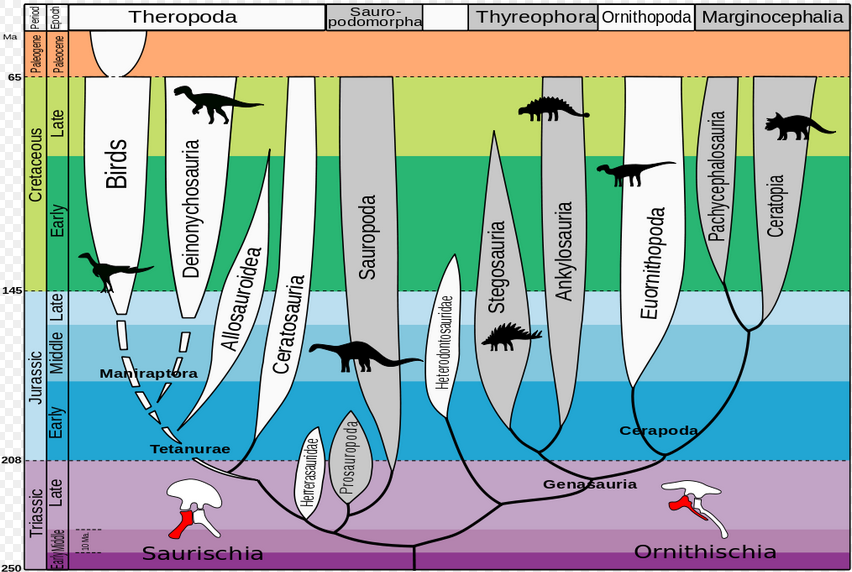How to Identify a Dinosaur
Although dinosaurs are undoubtedly the most famous extinct species, they are nevertheless poorly understood by many. In the worlds of dinosaur paleontologist Stephen L. Brusatte, “In popular parlance a dinosaur is often anything that is old, big, or frightening”, and this is simply not true. Dinosauria is a very specific taxonomic grouping which refers to a group of animals with the same common ancestor, and thus there is a complicated set of traits that determine exactly what animals fall within this classification.
Like most classifications, dinosauria has a simple definition, which is a good place to begin discussing its taxonomy. Dinosauria is the least inclusive clade (a taxonomic grouping that does not fit easily into the kingdom, phylum, order, class, family, genus, species categorization) that includes Triceratops horridus and Passer domesticus (the common house sparrow). Clades are created by visualizing the family tree of life, picking the two most genetically and physically dissimilar species that will be considered part of the clade, and tracing their lines on the tree back to their first common ancestor. All organism within this “triangle” will be part of the clade. If this seems confusing that’s because it is, determining what species to use and what the common ancestor is are extremely complicated questions. Paleontologists are expected to spend up to a decade of work buried in the problems posed by creating a new clade or merging multiple clades into one, or even moving species in and out.
One interesting thing to note from this is that all modern birds are considered dinosaurs. Although paleontologists agree that birds have anatomic features such as the wishbone which make them their own unique clade, their ancestry lies in the dinosaur clade, just as the ancestry of great apes such as humans lies with the primates. Likewise, dinosauria itself is contained within the reptile group Archosauria, a group of diverse reptiles noted for possession of gizzards, semi-upright or upright posture, and highly derived hearing and circulatory systems. Today the last surviving archosaurs are birds and crocodiles, but many species of archosaurs lived alongside the first true dinosaurs, and some of them bore very close resemblance to primitive dinosaurs. Although saying that all dinosaurs belong to a specific clade and thus have the same common ancestor is useful and clarifies a large amount of information to paleontologists, it does not solve the problem posed by the mess of very similar looking basal dinosaurs and dinosaur ancestor archosaurs. This requires a far more in depth study based around the traits shared by all dinosaur species, those referred to as plesiomorphic or homologous.
In any area of paleontology, there are thousands of possible traits, largely from fossil skeletons, that will be considered in order to determine how closely related various species are. These traits fall into the categories of plesiomorphic: ancestral to the group and homologous: unique to and characteristic of the group. Both of these are important to paleontologists as plesiomorphic traits are used to demonstrate general common ancestry and homologous traits track ancestry in detail. In determining where exactly archosaurs resembling basal dinosaurs start actually being basal dinosaurs, homologous traits are very important. Most of these animals would probably look very alike in the flesh, as they were all cat sized scaled reptiles that scampered around on two or four feet. To tell where dinosauria begins, paleontologists examine all the derived dinosaurs whose relationships with each other are clear. They look for their characteristic homologous traits, found in all of them and in no other animals. These features are not obvious things like numbers of toes, lengths of leg bones, or shapes of teeth. These may be useful for examining animals which are very closely related, but dinosaurs are diverse. The traits that bring them together are a set of seven subtle but very important biomechanical changes made over other archosaurs that allowed them to become strong enough and fast enough to claim the dominant position in Earth’s land ecosystems they would come to possess. If paleontologists can consistently find all these traits in fossils of a dinosaur ancestor archosaur (or indeed any other animal), then it is a true dinosaur.
The first trait is an extension of the jaw muscle called the mandibular adductor around the back corners of the skull and onto the skull roof. This can be seen in fossil bones based upon the position and size of two indentations called fossas, which are found on either side of the skull. These fossas were the anchoring point for the jaw muscles, and are almost nonexistent on all archosaurs except for dinosaurs, on which they consistently extend double the typical length and often far more. This trait indicates that dinosaurs had relatively strong bite forces compared to other archosaurs.
The second trait is the articulation, or meeting and interacting, of the cheek bones called the jugal and quadratojugal. They define the bottom rim of lateral temporal fenestra, a hole dinosaurs and some other archosaurs possess in their skull behind the eye socket. In other archosaurs this joint is very simple, just an overlap in which the jugal is further from the center of the skull than the quadratojugal. In dinosaurs the jugal has prongs which allow for a much stronger connection in which the two bones interlock. This corresponds to the improvements to the jaw muscles and indicates strong bite force.
The third trait describes the projections of bone on the top of the cervical vertebrae, the spine bones of the neck. No other archosaur has these. These projections vary in size between species of dinosaur, but all were probably used to anchor neck, back, and torso muscles. This feature improved the strength and flexibility of these muscles.
The fourth is the elongation of the deltopectoral crest, a ridge of bone on the humerus, or upper arm bone. This ridge anchors the deltoid muscle of the shoulder and pectoralis muscle of the chest. In dinosaurs it runs anywhere from 30-40% of the length of the humerus, whereas for most animals it runs only about 10%. This change served mostly to enhance the function of the pectoralis, which is pulling.
The fifth feature is very important, as it is the feature which allows dinosaurs to stand fully upright. It is an opening through the pelvis perpendicular to the spine called the acetabulum. This allows the legs an extremely wide ball and socket joint in which to operate, which is also very close to the center of the dinosaurs body. This allows the legs to stand in perfectly vertical position, as opposed to the sprawling posture of primitive reptiles and the semi-upright posture of most archosaurs. Even mammals cannot achieve perfect verticality, although in our case it is close enough to be insignificant. This would prove a massive advantage for dinosaurs in running, jumping, and supporting massive weight on pillar-like legs.
The sixth feature is an asymmetrical flange on the back of the femur called the fourth trochanter. It anchors the caudofemoralis muscles that extend to the tail and serve to pull the leg back during locomotion. For most archosaurs this feature is symmetrical and very subtle, though there are some with large but still symmetrical trochanters. This change probably served to increase running ability.
The final feature is an expansion of the astragalus, one of the ankle bones, at the expense of the other ankle bones. This means that out of the two lower leg bones the tibia is clearly dominant over the fibula, as the fibula’s joint is smaller and weaker. This also relates to fast locomotion, as this simpler structure is more efficient but less flexible.
In the first true dinosaurs this exhaustive list of features was subtle, but over millions of years it became exaggerated and allow dinosaurs to become as successful and adaptive as they were and are. The Clade dinosauria is divided into two groupings: saurischia and ornithischia. Saurischia contains Theropods: bipedal and often carnivorous dinosaurs including Tyrannosaurus and modern birds and Sauropoda: the long necked dinosaurs. Ornithischia contains Ornithopoda: Duck billed dinosaurs and their relatives, Thyreophora: armor plated dinosaurs such as Stegosaurus and Ankylosaurus, and Marginocephalia: dinosaurs with armored heads such as Triceratops and Pachycephalosaurus. You may note that this list does not include two groups often mistaken for dinosaurs. The first of these is the flying reptile group known as pterosaur, which was in fact a group of archosaurs closely related to dinosaurs but lacking the subtle homologous features shared by dinosaurs The marine reptiles that thrived during the era of the dinosaurs were not only not dinosaurs but not even one true clade. Each lineage evolved from some other point on the reptile family tree. Some other animals that are often categorized as dinosaurs are some of the larger archosaurs that are more like land crocodiles, but have a semi-upright posture, and scaly ancestors of mammals that a only distantly related to dinosaurs. If you look at an animal and are unsure if it is a dinosaur or not, the scientific criteria may be helpful even on a cursory glance. Remember to look for powerful jaws, neck bones with growths rising diagonally from the top, upper arm bones with long flat growths near the shoulders, hips with a giant hole in the middle, and legs with large growths on the femurs and large, solid ankle bones. These features may not seem so obvious, but take a look next time you’re at the museum. You may be surprised by how effective this identification is.
References
Brusatte, Stephen. Dinosaur Paleobiology. Chichester, West Sussex: Wiley-Blackwell, 2012. Print.
Paul, Gregory S. The Princeton Field Guide to Dinosaurs. Princeton, NJ: Princeton UP, 2010. Print.
Prothero, Donald R. Bringing Fossils to Life: An Introduction to Paleobiology. Boston: McGraw-Hill Higher Education, 2004. Print.











Whitney • Oct 14, 2015 at 12:44 pm
I still can’t believe I’m not perfectly vertical